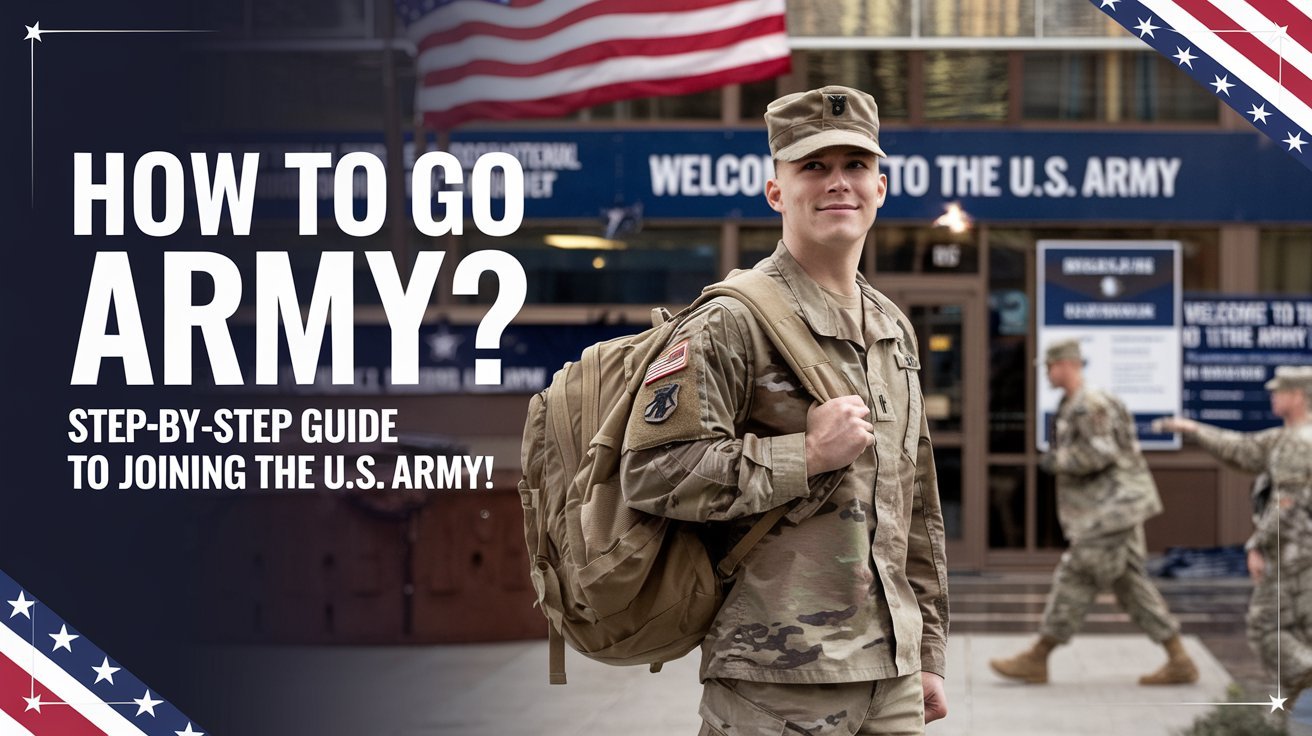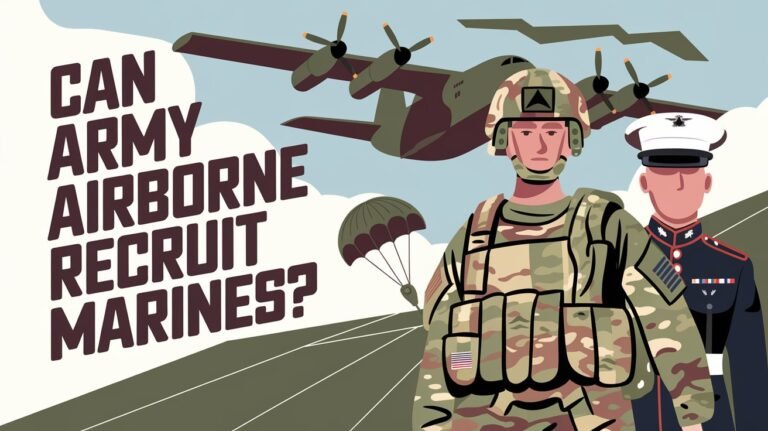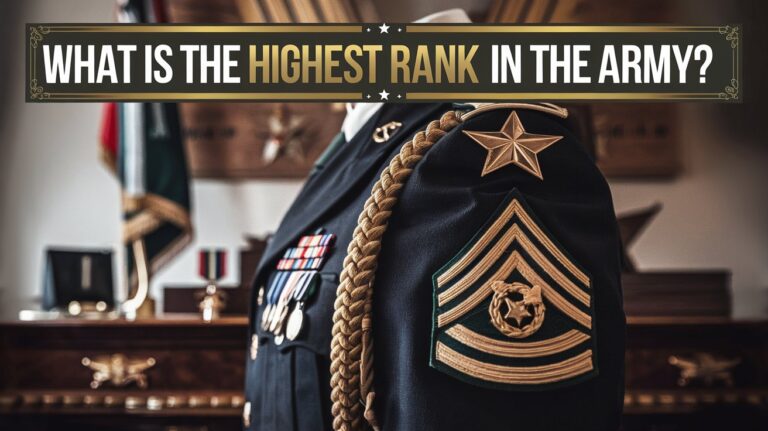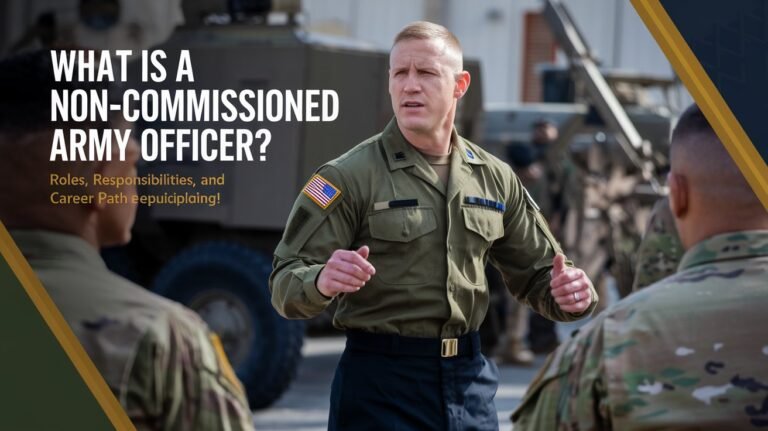How to Go to Army: Requirements and Process

Joining the U.S. Army opens doors to many opportunities. You can become an enlisted Soldier or an Officer. The enlistment process includes several steps. These are talking to a recruiter, taking an entrance exam, and a physical check-up.
Then, you pick an Army job and sign a contract. The requirements for joining the army are clear. You must be of a certain age, a U.S. citizen or have a green card, and meet educational standards.
The U.S. Army offers over 200 jobs. Whether you want a combat role, a technical job, or support services, this guide will help. It will show you how to join the army and start a fulfilling military career.
Basic Requirements for Army Enlistment
Starting a career in the armed forces is exciting and rewarding. It begins with meeting the Army’s enlistment requirements. These include age, citizenship, education, and physical fitness standards.
Age and Citizenship Requirements
Applicants must be between 17 and 35 years old to enlist. They must be U.S. citizens or have a valid Green Card. Non-citizens may face limited opportunities, so checking eligibility is key.
Male U.S. citizens and male aliens aged 18 to 25 must register with the Selective Service.
Educational Prerequisites
A high school diploma or GED is required for enlistment. Those with a GED need at least 15 college credits. A bachelor’s degree can lead to more career paths and officer roles.
Physical Fitness Standards
Physical fitness is crucial for Army life. Prospective Soldiers must meet height and weight standards based on age and gender. They also need to pass the Army Combat Fitness Test (ACFT).
The ACFT tests strength, endurance, and agility. Medical and moral fitness are also evaluated. Some disqualifying factors may be eligible for waivers.
| Requirement | Men (17-20 years) | Women (17-20 years) |
|---|---|---|
| Height | 58-80 inches | 58-80 inches |
| Weight | 234 lbs max | 119-227 lbs |
| ASVAB Score | Minimum 21 | Minimum 21 |
| ACFT | Required multiple times a year | Required multiple times a year |
How to Go to Army: Starting Your Journey
Starting your journey to join the US Army begins with contacting a military recruiter. These experts offer valuable guidance. They tell you about different career paths, benefits, and enlistment requirements. They also help schedule important steps like the entrance exam and medical check at the Military Entrance Processing Station (MEPS).
The army recruitment process has key steps. First, you must meet age and citizenship requirements. You must be at least 18 years old to enlist in the Army. The National Guard might accept 17-year-olds.
Having a high school diploma is highly recommended. It’s preferred over a GED for military service.
- The minimum age requirement to join the Army is 18 years old.
- The National Guard may accept individuals as young as 17 years old.
- Programs like Junior Reserve Officers’ Training Corps (JROTC) and Naval Reserve Officers Training Corps (NROTC) can provide a path to military enrollment after high school.
- Obtaining a high school diploma is recommended over a GED for military enlistment.
Physical fitness is crucial in the army recruitment process. You must show your physical readiness through tests like running, pushups, and sit-ups. Recruiters can guide you on these standards and help prepare for the tests.
The Armed Services Vocational Aptitude Battery (ASVAB) exam is a key step. It tests your skills and knowledge. This helps find the best military job for you. Taking the ASVAB is a must for military entry.
| Requirement | Details |
|---|---|
| Completing the ASVAB | The Armed Services Vocational Aptitude Battery (ASVAB) exam is essential for military entry. |
| Physical Fitness Standards | Prospective soldiers must demonstrate physical readiness through tests like running, pushups, and sit-ups. |
| High School Diploma | Obtaining a high school diploma is recommended over a GED for military enlistment. |
Working with a military recruiter and understanding the process, you can start a rewarding career in the US Army. The journey includes checking your eligibility, preparing for assessments, and exploring the many opportunities in this esteemed institution.
Military Entrance Processing Station (MEPS) Overview
The Military Entrance Processing Station (MEPS) is a key part of joining the army. It checks if you’re physically fit, have the right skills, and meet moral standards. You’ll spend 1-2 days at MEPS, and they’ll take care of your food and lodging if needed.
Medical Examination Process
At MEPS, you’ll get a full check-up. They’ll test your vision, hearing, and blood. They’ll also check your joints and body fat if you’re overweight.
Documentation Requirements
You’ll need to bring some important papers to MEPS. These include your Social Security card, birth certificate, and driver’s license. They’re used to check if you’re eligible to join the military.
MEPS Testing Procedures
- You’ll take the CAT-ASVAB test, a detailed test of your skills.
- If you pass the physical and CAT-ASVAB tests, you’ll learn about job options and enlistment.
- Then, you’ll have a final interview, get fingerprinted, and go through a pre-enlistment briefing before taking the oath.
The MEPS process makes sure recruits are ready for service. It checks your physical, mental, and moral health. This helps keep the United States Army’s standards high.
Armed Services Vocational Aptitude Battery (ASVAB)
The Armed Services Vocational Aptitude Battery (ASVAB) is a detailed test. It checks a person’s strengths and potential for success in military training. This exam, made by the Department of Defense, is key for joining the military and exploring careers.
The ASVAB tests many subjects like math, English, writing, and science. It’s given in two ways: pen-and-paper and computer-based, called the CAT-ASVAB. It usually takes 1.5 to 3 hours to finish. The scores help decide what jobs and paths are available in the Army.
The ASVAB Career Exploration Program (CEP) is special. It’s for exploring careers and is offered in schools, colleges, job corps centers, and correctional facilities. It helps people see their strengths and interests before joining the military.
The enlistment version of the ASVAB is taken at a Military Entrance Processing Station (MEPS). It’s for recruiting. You can retake the test after a month and also at a Military Entrance Test (MET) site.
The ASVAB test is only in English. You can’t take it in other languages. The Armed Forces Qualification Test (AFQT) score, from four ASVAB subtests, is important. You need a score of 31 or higher to enlist.
To do well on the ASVAB, start studying at least two months before. With good preparation, you can succeed in army training and enlistment.
Career Paths and Military Occupational Specialties
The U.S. Army has many career paths and special roles. These options are for different interests and skills. There are over 200 jobs in combat, technical, and support services. This helps people find the right job for their goals and talents.
Combat Roles
Combat roles mean being part of military actions. Jobs like infantry, armor, and special forces are in this category. They need great physical shape, tactical skills, and the ability to work well under stress.
Soldiers in these roles are key in defending the country. They also carry out important missions.
Technical Positions
Technical jobs in the Army need special skills. These include IT, engineering, and communications. They let Soldiers use their analytical and problem-solving skills to help the Army.
Many technical jobs offer chances to grow in your career. They also help you develop new skills.
Support Services
Support services in the Army cover many areas. These include logistics, healthcare, administration, and more. They make sure the Army runs smoothly.
Soldiers in support services do important work behind the scenes. They help the Army succeed in many ways.
No matter the career path, the Army offers great training. This helps Soldiers grow in their armed forces career paths. Career counselors help match interests and skills with the right army training programs.
| Career Path | Examples | Key Requirements | Benefits |
|---|---|---|---|
| Combat Roles | Infantry, Armor, Special Forces | Physical fitness, tactical expertise, ability to perform under pressure | Defend the nation, carry out critical missions |
| Technical Positions | IT, Engineering, Communications | Analytical and problem-solving skills, technical aptitude | Leverage specialized skills, opportunities for career advancement |
| Support Services | Logistics, Healthcare, Administration | Organizational skills, attention to detail, ability to work in a team | Ensure seamless operation of the armed forces, contribute to essential functions |
Army Basic Training Structure
Starting an army career means going through Army Basic Training. This tough program turns civilians into disciplined, fit soldiers. It covers physical fitness, weapons training, tactical skills, and military values.
The length and place of Basic Training depend on the soldier’s MOS. All recruits face a detailed program that boosts teamwork, leadership, and military skills. This phase is key for a successful army career, getting ready for the army lifestyle overview and future challenges.
The Basic Training Journey
Basic Training pushes recruits hard physically and mentally. A day starts at 4:30 AM with fitness, then breakfast and training with Drill Sergeants. The day is full, with classes, combat drills, marksmanship, and endurance exercises.
- Reception Week: Transition from civilian to army life, including farewell to family and physical fitness preparations.
- Week 1: Classroom instruction and adapting to army routines.
- Week 2: Field training, testing physical and mental endurance, and learning First Aid and map reading.
- Week 3: Mental and physical challenges with simulated combat drills.
- Week 4: Marksmanship training, teaching proper rifle handling and shooting skills.
- Week 5: Endurance and marksmanship skills testing.
- Week 6: Camaraderie and trust-building among recruits.
- Week 7: Applying training, building confidence through various exercises including hand-to-hand combat and obstacle course navigation.
- Week 8: Seven-day exercise to test all learned skills.
- Week 9: Final inspections in Class A uniform.
- Week 10: Graduation, marking the completion of army training programs.
The army training programs change civilians into skilled, disciplined soldiers. By Basic Training’s end, recruits are confident and ready for their army career.
Officer Career Pathways
The U.S. Army has many ways for people to become officers. You can join through the Reserve Officers’ Training Corps (ROTC), the U.S. Military Academy at West Point, Officer Candidate School (OCS), or direct commission options.
ROTC Programs
ROTC programs are found at over 1,700 colleges and universities across the country. These programs offer scholarships and leadership training. Students can get their bachelor’s degree and become officers at the same time.
After graduation, ROTC students must serve three to eight years in the Army.
Officer Candidate School
Officer Candidate School (OCS) is a 12-week program for enlisted Soldiers and college graduates. It’s a quick way to become an officer, starting as a second lieutenant.
Direct Commission Options
The Army also has direct commission options for professionals. This includes doctors, lawyers, and religious leaders. They can become officers without going through traditional training.
Direct commission officers must still go to a special officer training course.
To become an officer, you must be under 31 (with some exceptions). You need a bachelor’s degree and pass background checks and interviews. The Army’s officer corps is key in leading and commanding the armed forces career paths and army recruitment process.
Military Benefits and Compensation
Joining the Army comes with many benefits and rewards. These go beyond just the pay. In 2024, active-duty and reserve members got a 5.2% pay raise. This shows the Army’s commitment to its soldiers.
Service members get 30 days of paid leave each year. They also get all federal holidays off. They might get extra housing and food pay, based on their rank and location.
For those stationed overseas, there’s the Overseas Cost of Living Allowance (OCOLA). It’s a non-taxable allowance that changes based on pay grade and dependents.
The Army also offers special pays for certain duties. This includes Hardship Duty Pay and Hazardous Duty Incentive Pay. These rewards show the Army values its soldiers’ unique contributions.
Army lifestyle also offers great personal and professional growth. Soldiers learn leadership, teamwork, and problem-solving. They also enjoy the support of a close community.
| Benefit | Description |
|---|---|
| Tuition Assistance | Up to $4,500 per fiscal year for education |
| Servicemembers’ Group Life Insurance | Coverage of up to $500,000 at $31 per month |
| Montgomery GI Bill (MGIB) | Up to 36 months of education benefits for eligible Service members and Veterans |
| TRICARE and VA Benefits | Healthcare coverage for Service members and their families |
| Concurrent Retirement and Disability Pay (CRDP) | Gradual restoration of retired pay offset by VA disability pay |
The Army offers more than just financial benefits. It provides healthcare, education, and personal growth opportunities. The Army’s supportive community adds to the many advantages of serving.
Army Reserve and National Guard Options
The army recruitment process has part-time service options. These are through the Army Reserve and National Guard. They let people serve while keeping their civilian jobs. These paths are different from full-time active duty jobs.
Part-time Service Commitments
Serving in the Army Reserve or National Guard means one weekend a month. You also get two weeks of annual training. The length of your service contract can be three to six years, based on your job and needs.
The minimum age to join the National Guard or military reserves is between 17 and 42 years old.
Specialized Training Programs
- The Army National Guard units are located in all fifty states, the District of Columbia, and U.S. territories such as Guam, Puerto Rico, and the Virgin Islands.
- The average deployment length for Army National Guard Soldiers is nine months in combat regions, with varying lengths in non-combat regions.
- Army National Guard Soldiers may be eligible for bonuses for high-demand and low-density skills in the Reserve component.
- National Guard members who sign up for at least six years can receive up to three years of educational assistance.
- Reservists on active duty for more than 30 days receive comprehensive medical and dental care at no cost.
- Reservists can earn points toward a reserve retirement by serving in the reserve component.
The army recruitment process offers flexible part-time service options. These are through the Army Reserve and National Guard. They provide chances to serve while keeping civilian careers and access to specialized training programs.
Security Clearance and Background Checks
Security clearances and background checks are key in military enlistment and the army recruitment process. The level of clearance needed varies by Military Occupational Specialty (MOS).
The background check looks at your criminal records, financial history, and personal references. Some jobs need deeper investigations to check if you’re trustworthy.
You must be honest about all relevant information during the security clearance process. Keeping your clearance is a big responsibility in your Army career.
- At least 10 years of personal information required for jobs that necessitate a security clearance.
- Fingerprinting required for individuals who have never worked for the Federal Government.
- The type of background check – Public Trust or Security Clearance – depends on the job requirements.
- Sensitivity and risk levels in federal jobs categorized from non-sensitive to special sensitive and low risk to high risk.
The trust determination process has different background investigations based on job sensitivity and risk. The credentialing process also checks if you can get an identity card for federal access.
To get a Top Secret/Sensitive Compartmented Information (TS/SCI) clearance, you need to show loyalty and have good character. This clearance is needed for many military roles.
Giving false information or hiding details on forms can hurt your job chances. Also, refusing a drug test or testing positive without a medical reason can mean no job offer.
Oath of Enlistment and Final Steps
The Oath of Enlistment is the last step in joining the army. It’s when you officially start your military service. You promise to support and defend the U.S. Constitution. This oath is taken by every service member, showing their commitment to their duties.
After swearing the oath, recruits either go straight to Basic Training or join the Delayed Entry Program (DEP). The DEP lets future Soldiers start Basic Training later, usually within a year. This gives them time to get ready for the tough training ahead.
The last steps include getting your reporting instructions and making sure all documents are ready. You might also have questions or concerns to ask your recruiter. Once you’ve sworn the oath, you’re ready to start your army journey.
Popular Questions
What are the main paths to join the U.S. Army?
You can join the U.S. Army as an enlisted Soldier or an Officer. Enlisted Soldiers do daily tasks. Officers lead and make big decisions.
What are the basic requirements for Army enlistment?
To enlist, you must be 17-35 years old. You also need to be a U.S. citizen or have a green card. Lastly, you should have a high school diploma or GED.
How does the Army enlistment process work?
First, you talk to a recruiter. Then, you take an entrance test and a physical exam. Next, you pick a job and sign a contract.
What happens during the Military Entrance Processing Station (MEPS) visit?
At MEPS, you get medical checks, aptitude tests, and moral assessments. It usually takes 1-2 days. They provide food and lodging.
What is the ASVAB test, and why is it important?
The ASVAB is a test that shows which Army jobs you’re suited for. It tests math, English, writing, and science. Your scores help pick your job.
What are the different types of Army career paths?
The Army has over 200 jobs in fields like combat, tech, and support. Career counselors help find the right job for you.
What is the structure of Army Basic Training?
Basic Training turns civilians into Soldiers. It teaches fitness, weapons, tactics, and discipline.
What are the different pathways to become an Army Officer?
You can become an Officer through ROTC, West Point, Officer Candidate School (OCS), or Direct Commission.
What are the benefits of serving in the Army?
Serving in the Army comes with good pay, housing, healthcare, education benefits, retirement plans, life insurance, and access to military facilities.
What are the options for part-time Army service?
The Army Reserve and National Guard offer part-time service. This lets you keep your civilian job. They have different rules than active duty.
What is involved in the security clearance and background check process?
Clearances and background checks are part of joining. The level needed depends on your job. You must be honest about your past.
What is the Oath of Enlistment, and what happens after taking it?
The Oath is a promise to defend the U.S. Constitution. After, you either go to Basic Training or the Delayed Entry Program (DEP).






